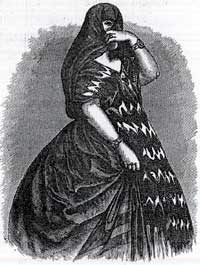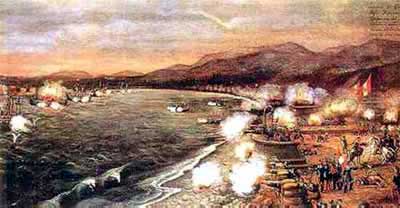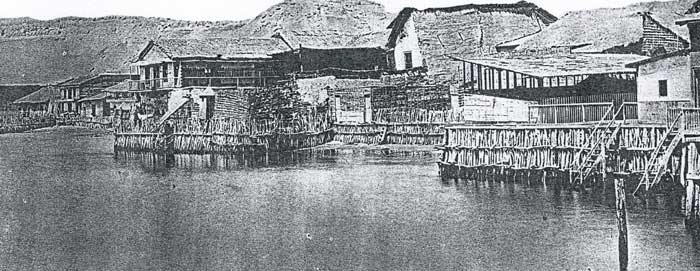|
Two Years in Peru appeared in London in
1873. The book was published in two volumes, and it is a
compilation of Hutchinson's trips and archaeological
explorations in the Andean country. The first chapters include
accounts of the journey from Liverpool to Lima, with full
descriptions of the Strait of Magellan, Tierra del Fuego and
Punta Arenas, the indigenous people of southern Patagonia and
Chile, the Chiloé archipelago, Valparaíso, Santiago, Iquique
and Tarapaca, and of his arrival at Callao, a major port near
Lima. In the chapters that follow, there are scientific
deliberations, including medical, ethnographic and
archaeological observations of places in central and northern
Chile, present-day Bolivia and south Peru.
On Lima and
its port, Callao, the author included reports and statistical
information on trade, agricultural production, industry,
shipping, railways and mining, as well as security, health,
education, immigration policies, demographic information,
local politics and even customs - among them the 'sleepiness'
- of the Peruvian people. Both volumes are richly illustrated,
including numerous pencil sketches by José Maria Zaballa and
John Schumaker, and a number of heliotype pictures, a
higher-resolution photographic technique which was pioneered
in the 1870s in Lima by V.L. Richardson.
|

Tapada, a custom of Lima ladies
(Two Years in Peru)
|
One of the
accounts, in chapter 11, tells of the 'Bombardment of Callao
by the Spanish fleet in 1866' (Hutchinson 1873: 223). In 1866,
Spanish forces occupied the Chincha islands, major world
producer of guano fertiliser. Peru, Ecuador, Chile and Bolivia
united their forces against Spain in what was called the War
of the American Union (1864-1867). In February a
Chilean-Peruvian army successfully battled the Spanish armada
in Abtao, and on 31 March the Spanish forces attacked
Valparaíso in Chile. At noon of 2 May 1866 the Spanish ships,
led by the iron-clad Numancia, began shooting at the
fort of Callao.
After fierce fighting between the invading navy and the
Peruvian forces on land, the Spanish abandoned the battlefield
and '2 de Mayo' is still celebrated as a Peruvian victory.
[9]
The commander who ordered the retreat of the Spanish fleet was
rear-admiral Miguel Lobo y Malagamba (1821-1876), a seasoned
naval officer with experience in Africa and America, who would
consider Hutchinson'ss writings to be a series of dislates
(nonsense).
In 1874,
Miguel Lobo published Un hijo de Inglaterra a quien le ha
dado por viajar en las Regiones Americanas que fueron de
España y por escribir sendos dislates sobre ellas y sus
antiguos dominadores. [10] Each of the seventy-seven pages
of this book are dedicated to demolishing the information and
ideas included in Hutchinson's Two Years in Peru. This
long diatribe - without any division in chapters or even
subtitles - was written to counter the neglect of the Spanish
authors to defend 'the prestige of Spain and the historical
truth regarding the conquest of America'
(Lobo 1874: 5).
After ten
pages including remarks about Hutchinson's
ability as a travel writer, the author of Un hijo de
Inglaterra focuses on linguistic criticism. When
Hutchinson criticises the fact that the Spanish conquistadors
changed numerous Inca place names, Lobo counter-attacks with
the English-language toponyms that are frequent in the
Magellan Strait and were named by English expeditions. Then he
reproaches the consul's translations from Spanish into
English, including that of perder los estribos as 'to
get confused or embarrassed', which Lobo argues is enough to
evaluate the bad translations in Hutchinson's book: 'we can
certainly assume that our readers [...] will exclaim ab uno
disce omnes' (13). [11]
Next in
Lobo's condemnation is spelling, in particular the question of
the 'ñ':
Of course the Spanish linguistic knowledge of Mr.
Hutchinson [...] has nothing to do with the fact that, without
the authorisation of the Spanish Academy - incidentally, an
authorisation which no British authors seek - he omits one of
the letters in the Spanish alphabet, the ñ. But, not
content with this ab-irato banishment, it is also
imposed upon the r, when two of them happen to be
unfortunate enough to occur together in a Spanish-language
word. Therefore, instead of Carrillo, a Peruvian
engineer, we see this name written, ex-officio by Mr.
Hutchinson, with the nickname Carillo. And the
delicious fish in the north of Peru's
coast [...] that is known as Mojarrilla, is
re-christened mojarilla (14). [12]
This apologia
of the ñ, which is indeed justifiable from a purely
linguistic point of view, is somewhat biased by the palpable
intolerance of the author towards everything that is not
Spanish. It would be worth attempting a comparison of this
narrow-minded passage with the enjoyable 'La eñe también es
gente' by the Argentine author María Elena Walsh.
[13]
Also visible
in Lobo's work is his vindication of the Spanish conquest of
America. 'So all the South American histories say that in
general the Christianisation by the Spaniards in those
countries was limited to raising crosses on the hill tops, to
building chapels in suitable places, and to changing the
original place names to others with the names of saints! [...]
So then it is nothing to succeed in propagating throughout the
largest part of the New World a language that is one of the most beautiful
languages, and with it, one of the most original and precious
of literatures' (31). [14]
|

The battle at Callao, 2 May 1866 |
But the most
important evaluation of Two Years in Peru by Miguel
Lobo seems to be focused on an event that he witnessed
first-hand, the attack on Callao
by the Spanish fleet on 2 May 1866. All the details offered by Hutchinson
are challenged by Lobo. When Hutchinson reports that the
Spanish battleships 'had all got such a peppering' that at
five in the afternoon they had to withdraw (Hutchinson 1873:
II, 234), Lobo says instead that the officers were just
following their orders (Lobo 1874: 71-73).
Conclusion
Miguel Lobo's
book abounds in bigoted interpretations of both British and
Latin American cultures. His comments - though partially true
in some aspects of Hutchinson's book - are guided less by a
genuine defence of Latin American cultures than by an attitude
of considering the Spanish culture superior to that of the
British empire, which is typical of an obsolete way of
thinking among Spanish officials in the second half of the
nineteenth century. Lobo's beliefs draw on the imperialist
approach to cultures different to one's own, in which the
colonialist mind only perceives powerful enemies or colonised
peoples.
Incapable of
even a minimal recognition of Hutchinson's work, or at least
an objective criticism of the book, in the closing paragraph
Miguel Lobo scoffs at the way some English-speaking people
pronounce words in Spanish: 'Sr. Hutchinson, otra vez, no dice
V. nonsenses, no tonterrias' (77).
Edmundo
Murray
Acknowledgements
I am obliged
to Edward Walsh of London
for his generous hospitality and his expert guidance through
the intricacy and formalities of the city's various libraries
and archives. I am also grateful to Roberto Landaburu of
Venado Tuerto for sharing interesting information about Thomas
Hutchinson with me, and to the genealogist Helen Kelly of
Dublin for her research in Wexford archives.
Notes
[1] Scornful
use of incorrect Spanish syntax and spelling by a native
speaker of English (Lobo 1874: 77).
[2] The county
of birth may also have been Kilkenny. In this case, his father
was Alfred Hutchinson [Hutchenson].
[3] The year of
graduation may be inaccurate. No records have been identified
in the University of
Göttingen of
Hutchinson's studies or his thesis dissertation (thanks to
Juan Delius and Ulrich Hunger for this information).
[4] Present-day
Malabo, the capital of Equatorial Guinea.
[5] A list is
included in the Appendix following this article.
[6] The
complete collection of the Argentine Citizen has been
microfilmed by Museo Mitre of
Buenos Aires.
[7]
'Hutchinson,
Antigüedades del Perú. No conozco esta obra, ni necesito
conocerla para saber que ha de contener muchas noticias de
interés; pero redactadas sin orden ni método científico.
Hutchinson es un original que tiene la pasión por los viajes,
para escribir sobre ellos libros que han tenido poca
aceptación en Inglaterra, según me ha informado el capitán
Burton, el famoso viajero del Africa Central. Ha escrito sobre
la expedición del Níger en Africa, de la que formó parte. Aquí
ha sido, por algunos años, cónsul de Inglaterra en el Rosario,
y ha escrito dos obras sobre la República Argentina, una de
las cuales lleva mi retrato al frente. No obstante mi
estimación por su persona, mi gratitud por su distinción y el
honor que hago de su infatigable actividad, debo declarar que
sus libros, conteniendo algo útil, no responden a ninguna
idea, ni tienen un carácter durable. Su mejor obra es sin duda
un periódico estadístico-comercial en inglés, que publicó aquí.'
(Bartolomé Mitre to Diego Barros Arana, 20 October 1875, in
Payro 1906: 197).
[8] This income
was subsequently increased to £900 plus £400 allowance after
complaints made by Hutchinson (FO 61/274).
[9]
Independence from Spain was won in 1824 at the battle of Ayacucho, but Spain did not recognise the Republic of
Peru until
1855. After the War of the American Union, the final peace
treaty between Peru and Spain was signed in 1880.
[10] Lobo's
book title could be translated as A son of
England who took it upon himself to travel through the
American regions that belonged to Spain, and to write nonsense
about them and their former masters.
[11]
Y ante semejante interpretación lengüística de
nuestro británico viajero podemos presumir, sin miedo de
equivocación, que nuestros lectores, concediéndonos les
acompañemos en ello, dirán, refiriéndose á los conocimientos
del idioma del mismo señor Hutchinson, ab uno disce omnes.
[12]
Por supuesto que la erudición
filólogo-castellana del Sr. Hutchinson, cuya muestra, puede
decirse, tenemos ya de cuerpo presente, nada tiene que ver con
que sin permiso de la Academia Española (permiso, que, por
otra parte, suelen para ello tomarse todos los escritores
británicos), suprima una de las letras del alfabeto castellano,
la ñ. Y no contento con este destierro ab-irato,
impóneselo también á una de las r, cuando dos de ellas
tienen la desgracia de figurar juntas en una palabra española;
así es, que en vez de Carrillo, apellido de un
ingeniero peruano, vemos á éste, ex-officio el Sr.
Hutchinson, con el sobrenombre de Carillo; y al sabroso
pescado que en la costa Norte de la República, teatro de las
recientes andanzas de este señor, es conocido por
Mojarrilla, bautizado con el nombre de Mojarilla.
[13] Walsh, María Elena, 'La eñe también es gente' in Ministerio de
Educación, Ciencia y Tecnología (Argentina), Efemérides
Culturales Argentinas: María Elena Walsh. Available online
(http://www.me.gov.ar/efeme/mewalsh/laenie.html), accessed 21
August 2006.
[14]
¡Conque
toda la historia de América Meridional enseña, que en general,
el cristianismo de los españoles, en aquellos países, redújose
á levantar cruces sobre los cerros, á edificar capillas en
adecuados parajes, y á cambiar los nombres primitivos por
otros de santos! [...]
¡Conque
no es nada el haber logrado extender, por grandísima parte del
Nuevo Mundo, una lengua de las más hermosas, y con ella, una
literatura de las más originales y ricas!
References
- Burton,
Richard Francis (generally attributed to). A F.R.G.S.
Wanderings in
West Africa:
from Liverpool to Fernando Po (London: Tinsley, 1863).
- Cutolo,
Vicente Osvaldo. Nuevo Diccionario Biográfico Argentino
(1750-1930) (Buenos Aires: Elche, 1968). Vol. 3.
- FO: UK
National Archives (Kew), Catalogue Reference: FO (Foreign
Office). Consul at Fernando Po: 2/13, 2/15, 2/16, 2/19, 2/25, 2/29, 2/35, 2/40, 84/975, 84/1001,
84/1030, 84/1061, 84/1087, 84/1117. Consul at Rosario:
6/236, 6/242, 6/247, 6/252, 6/259, 6/264, 6/270, 6/278, 6/286,
6/294. Consul at Callao: 61/261, 61/269, 61/274, 61/280,
61/286.
- Lobo,
Miguel. Un hijo de Inglaterra a quien le ha dado por viajar
en las regions Americanas que fueron de España y por escribir
sendos dislates sobre ellas y sus antiguos dominadores
(Madrid: Imprenta y librería de Miguel Guijarro, 1874).
- Marshall,
Oliver.
The English-Language Press in Latin America (London:
Institute of Latin American Studies, 1996).
- Payró,
Roberto (ed.). Páginas de historia: Bartolomé Mitre
(Buenos Aires: La Nación, 1906). Online available (http://www.e-libro.net/E-libro-viejo/gratis/paginas.pdf),
accessed 16 August 2006.
- Platt,
D.C.M. The Cinderella Service: British Consuls since 1825
(Hamden, Conn.: Archon Books, 1971). |




